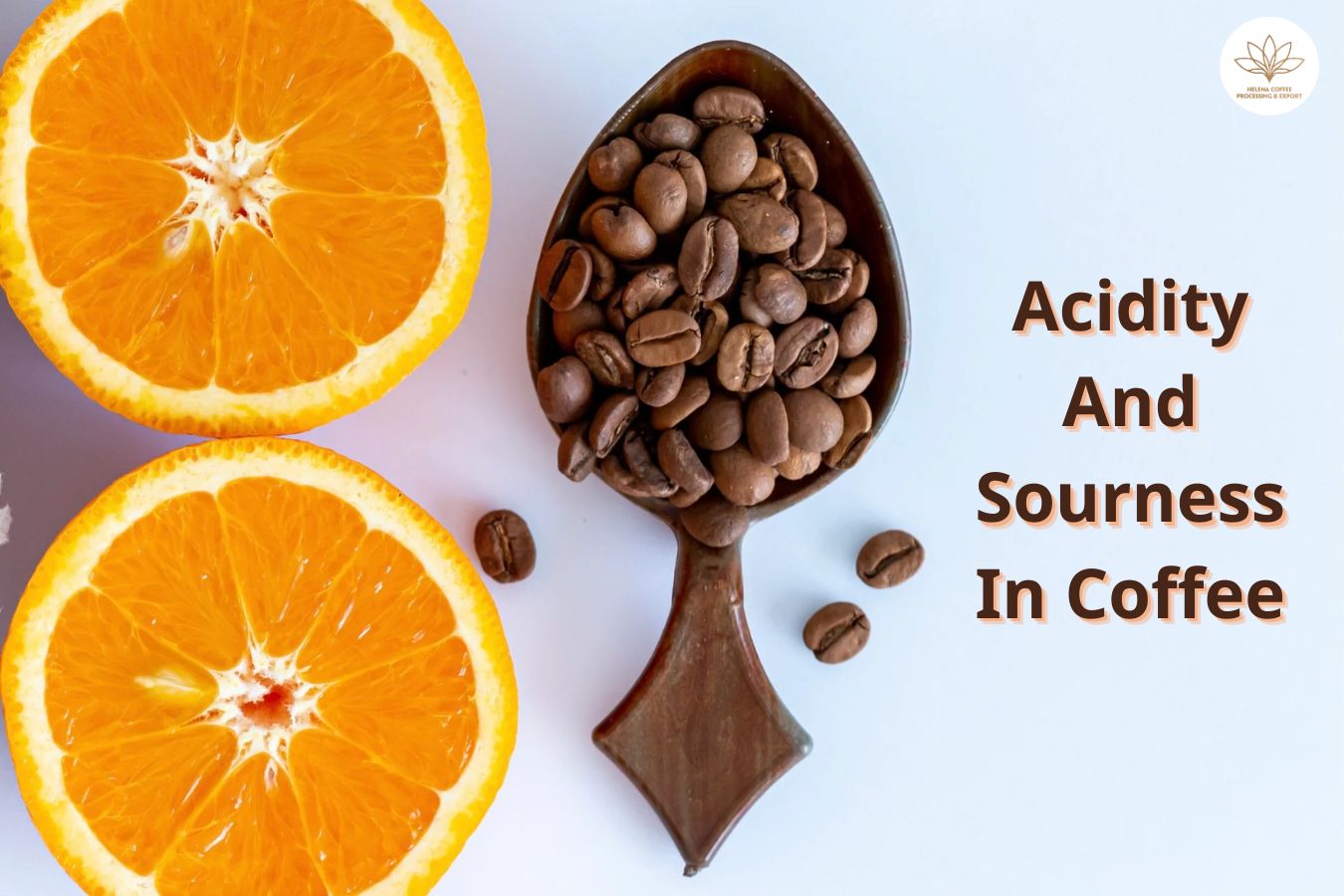
Acidity And Sourness In Coffee: Acid is recognized as a major contributor to the sensory experience of coffee, and coffee experts appreciate this flavor and adjust their roasts accordingly. If you have ever cupped with some connoisseurs, you may have heard some comments such as: “ This coffee exhibits a distinctly sour taste of malic acid when hot, which gives way to citric acid when hot. it’s cold… ” Some of us, may even be familiar with the taste of some of the organic acids commonly found in coffee – citric, malic, lactic, acetic – and are confident that we can distinguish them by taste.
However, in a scientific article titled ” Acids in brewed coffees: Chemical composition and sensory threshold ” recently published, the authors This hypothesis shows that the content of many organic acids in coffee after brewing is so low that it is essentially undetectable. They also tested whether coffee experts could taste the difference between citric acid and tartaric acid in coffee. Their findings challenge many of the assumptions we make about how different acids in coffee affect flavor.
At concentrations commonly found in brewed coffee, coffee experts were unable to accurately identify any organic acids in sensory testing. In fact, for acetic, lactic and malic acids, the levels found in the coffee they brewed were so low that they were below the detection threshold, which is completely undetectable.
According to the researchers, their findings call into question the methods widely used in specialty coffee to train and test the sensory skills of experts, aka Q Graders. . For example, even in lightly roasted coffees, the levels of most organic acids in brewed coffee are much lower than the levels used in the Coffee Association’s sensory tests. Specialty Coffee (SCA) and Coffee Quality Institute (CQI). Not stopping there, the research team also broke our long-standing prejudices about acidity (or acidity in coffee ), researchers discovered the lowest pH, and highest citric acid concentration in coffee. Brazilian coffee they tested. Meanwhile, Kenyan coffee has less citric acid and a higher pH, despite the fact that most of us know Kenyan coffee has very high acidity.
Acid tests
The standard procedure for testing acid taste in coffee, used by both the SCA and CQI, is to “spike” coffee brewed with organic acids. SCA uses citric, malic, lactic and tartaric acids in the Sensory Skills Professional test , while CQI tests citric, malic, acetic and phosphoric acids as part of the Q test. grader .
In each case, the trainer typically adds 0.4 grams of each acid to a liter of brewed coffee (or 0.5 grams in the case of lactic acid). For the CQI course, the instructor will select two beakers out of four and ask students to find which two beakers had acid added to them (the “matched pairs” test). The SCA certification goes a step further by testing the student’s ability to determine which acid was added to the beaker. The purpose of the tests is that the amount of acid added should be detectable – in fact, SCA guidance asks trainers to “adjust to taste” if necessary, to ensure that the student can taste get the difference between the cups.
However, with the exception of citric acid, the researchers found that the concentrations of each of these acids in brewed coffee were much lower than those used in the SCA and CQI tests . They tested five different specialty coffees : two naturally processed coffees from Brazil, two wet-processed coffees from Kenya, and one wet-processed coffee from Bolivia. For each coffee, the researchers tested three different roast levels (within the light roast range common to specialty coffees).
Light-roasted, specialty coffee is quite acidic – but of the acids tested according to the CQI and SCA protocols , only citric acid reached the level (0.4 grams per liter) used in the tests. experience. Two other important acids – chlorogenic acid and quinic acid – are present in higher concentrations, but their role in flavor is still debated and they are not included in routine sensory tests.
Detection threshold
Sensory tests for acidity are based on the assumption that common organic acids have a significant influence on the flavor of coffee and help distinguish different types of coffee. But many of these acids are undetectable at the low concentrations found in brewed coffee. The researchers brewed coffee extracts with varying doses of acid and tested them on a group of coffee experts – in this case, bar managers from roaster Copenhagen Coffee Collective . All participants received prior training on organic acid recognition, as well as 30 min of intensive training immediately before taking the test.
They found that at concentrations typically found in coffee, participants could not identify any acid in the tests. In fact, for most acids, participants could not even detect whether any acid had been added. When tasting acid in plain water, rather than in brewed coffee, participants only correctly identified acetic acid.
Identify acids in water and coffee. Cupping candidates were unable to detect any acids at typical concentrations found in coffee. In the water, they were able to determine the presence of acetic acid, but no other acids were detected . The bold horizontal bar indicates the number of correct answers needed for a statistically significant result.
By adding different amounts of each acid to the coffee, the researchers calculated how much they needed to add to the coffee to be able to detect a difference in the cup – or “detection threshold.” According to the research team’s results, the average concentration of malic, lactic and acetic acids in brewed coffee was below the detection threshold , while the average concentration of phosphoric acid was only slightly above the detection threshold. The only acid that is clearly detectable at the concentrations found in coffee is citric acid.
The concentrations of some important organic acids in brewed coffee are below the detection threshold . The dark columns represent the concentration in the coffee (brewed using a French press) and the light columns represent the amount of acid that needs to be added to be able to taste the difference.
These results contradict the idea that changes in the concentration of individual organic acids determine the flavor of coffee. Adding acid to coffee in this way doubles its acidity, but the difference may not even be noticeable.
TDS and acid concentration
In the above study, the authors brewed coffee using a French press, with a concentration of about 1.1% TDS , as they considered this to be the method most similar to cupping, used for sensory evaluation. This style of coffee is somewhat weaker than the coffee most people drink, does that mean the acid will be more easily detected in stronger coffee? After all , the way coffee is brewed has a strong impact on acidity: In terms of both titratable acidity and perceived acidity; Coffee brewing parameters make almost as much difference as roast level.
However, simply increasing the total dissolved solids (TDS) concentration of the coffee extract does not mean that the amount of acid in it will be higher than the detection threshold. First, the detection threshold in the study was specific to the brew strength they used – in other words, it was the amount of acidity that could be tasted in that coffee. An extract with a higher TDS may have an even higher detection threshold, because the concentration of all the other compounds in the coffee will also increase, making it difficult to taste individual acids. than.
For example, imagine you’re adding citric acid to a shot of espresso, then you add that same measure of sugar to filter coffee brewed with the V60 . You will be much less likely to taste sourness in espresso than in filter coffee – in other words, the stronger the coffee, the higher the detection threshold .
That said, choosing the French press as your coffee brewing method creates complications. “French press coffee has much higher levels of oils, melanoidins and microparticles that enhance mouthfeel and can ultimately “hide” specific nuances.” In contrast, in the SCA and CQI tests , the tasting is based on filtered coffee – according to Joseph Rivera, CQI Course Co-Developer
Acidity # Acidity
In this study, Kenyan coffees had the highest pH – in other words, they had the least acidity. This is surprising when you consider the distinctive flavor of Kenyan coffee, but this isn’t the first time researchers have found similar results. For example, one research group found that Kenyan coffees have less citric acid but more malic acid than Central American coffees ( Balzer, 2001 ). Another study found that East African coffees generally have higher pH than Central American coffees ( Brollo, et al., 2008 ) .
Not all acids contribute equally to the perceived acidity of coffee. A coffee’s perceived acidity – in other words, its sour taste – appears to correlate more with its “titratable acidity” than its pH or total acidity . Titratable acidity is a measure of the amount of alkalinity that needs to be added to completely neutralize the acid in the coffee. Some compounds in coffee can buffer acidity, meaning that changes in the concentration of some acids may have only a small effect on pH. Readers of Extraction Science will notice that this is the same concept as alkalinity, but in reverse.
At room temperature, in 1 mole of acetic acid solution (with chemical formula CH 3 COOH), only 0.4% of acetic acid is dissociated into acetate ion (CH 3 COO − ) and hydronium ion (H 3 O + )
The combination of acids present in the same solution can also affect the taste: for example, citric acid and malic acid have a synergistic effect. Combined, they are more sour and more astringent than either acid alone ( Rubico and McDaniel, 1992 ). On the other hand, bitter compounds like quinic acid can mask some of the acidity of coffee. Coffees from Brazil in the above study contained more quinic acid, which may partly explain why they had lower acidity levels ( Birke Rune et al., 2023 ).
An interesting study also showed that our perception of coffee acidity is influenced by the coffee’s aroma. Specifically, the researchers also found that Kenyan coffees have a higher pH and lower titratable acidity than Central American coffees. However, when the cupping panel wore nose clips to block the coffee’s aroma, the tasters rated the Kenyan coffee as having lower acidity than other coffees – consistent with the coffee’s acidity measurements. pH and titratable acidity ( Brollo, et al., 2008 ).
This may be similar to how we perceive sweetness in coffee. Most roasted coffee does not contain enough sugar to detect sweetness; instead, perceived sweetness comes from a multisensory effect , aromas in coffee associated with sweetness such as caramel or vanilla.
Acids are not just acidic
The acid content in coffee not only affects acidity. Some acids found in coffee have recognizable aromas, such as the characteristic vinegar smell of acetic acid or the burnt caramel smell of pyruvic acid. Many acids can also impart a bitter or astringent taste to coffee, or even act as flavor modifiers, changing the taste of coffee even when they don’t have a characteristic flavor.
Chlorogenic acid in coffee is sometimes associated with a sour taste and sometimes with a bitter or metallic taste. It may be because chlorogenic acid has little flavor of its own, but rather the molecules formed when chlorogenic acid breaks down that express that flavor in coffee.
In short, this analysis is quite long – as the name of the study Acids in brewed coffees: Chemical composition and sensory threshold , clearly shows that the acidity level in coffee does not determine the difference in taste of coffee. from different origins. Typically, the sour taste of Kenyan coffee depends not only on the amount of acid it contains. Meanwhile, factors such as roast level or processing method appear to have a greater influence on perceived sourness in coffee than geographical origin.
So, do these results imply that the SCA and CQI tests are fundamentally flawed? It is difficult to conclude, but it is worth noting that the cuppers in this study were experienced coffee professionals but they were not Q graders. And so it is possible that training towards CQI (or SCA) certification will enable tasters to detect and even identify acids at lower concentrations.
However, this is where we need to reconsider descriptions like “malic acid”… which sounds scientific but does not reflect the reality of how we enjoy coffee. Although acidity can be measured, how we perceive acidity is highly subjective. A description such as the acidity of a green apple or a yellow orange would be much more meaningful to our customers.
FAQS:


